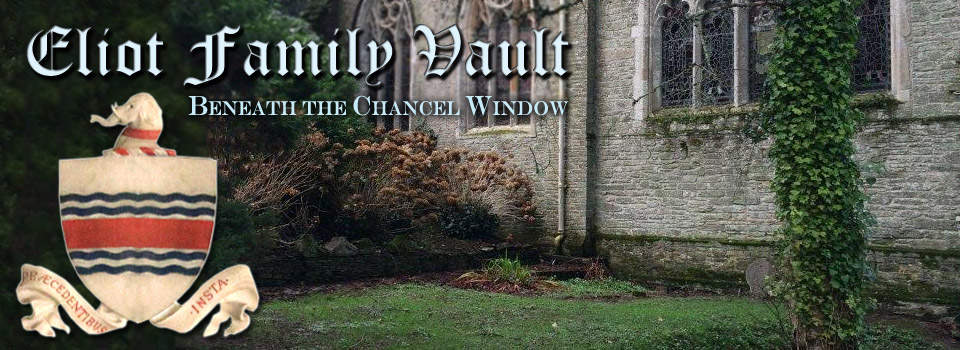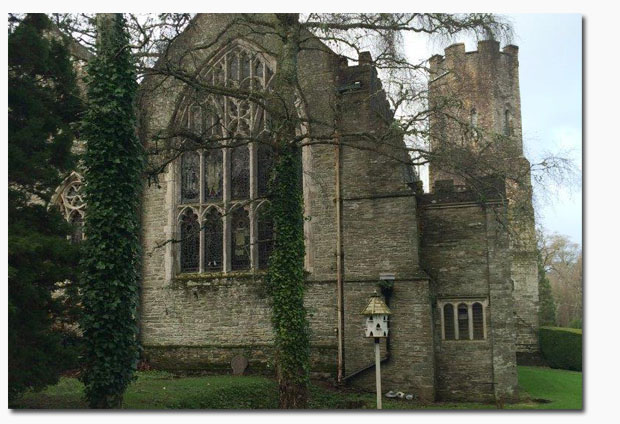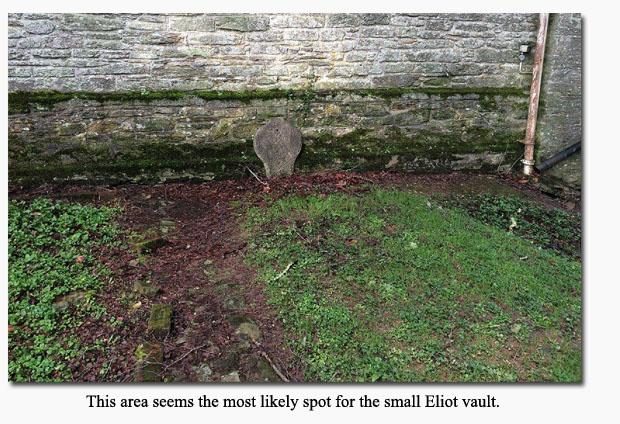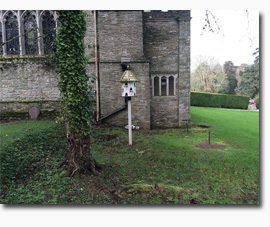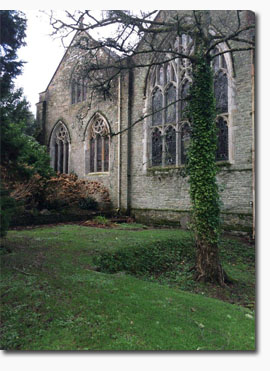The Eliot Family Vault Below the Chancel Window of St. German's
Since the purchase of Port Eliot in 1565, the Eliots of Port Eliot have had a large family vault below the Lady's Chapel (or Chancel) of St. German's Church. Family burials took place there until the close of the eighteenth century, at which time the family began to use their new vault in the "new" churchyard (now called the "Old Cemetery"). Lesser known, however, is the fact that – during the mid-18th century – the Eliots had built a small vault against the outside wall of the church, below the eastern Chancel window and in "the grounds of Port Eliot". The only recorded description of this vault states that it was made of brick.
"Discovery" of the Small Vault
This small family vault soon sank into oblivion, lost to time for nearly 200 years. Enter Montague Eliot (later 8th Earl of St. Germans), during the 1920s, with his series of excavations in the Port Eliot lawn between the house and the church, hoping to find the foundations of some old cloister walls or, better still, an ancient crypt. In April of 1928, newspaper reports stated that "on the whole these excavations have yielded much less than might have been reasonably expected, granted that the choir or conventual church stood on this site. The whole area seems to have been repeatedly disturbed in the 18th century for the constructions of brick and stone drains. Immediately below the east window of the church, on the outside, is a large vault of brick, built at the close of the 18th century to contain two coffins." This discovery may have been disappointing and worth little note to the excavators of the 1920s, but – in terms of the Eliot family history – this was a far better find than any ancient crypt or wall.
Identifying the Burials
Because the St. German's parish registers are incomplete and devoid of anything resembling record notes (not even do they differentiate between burials in vaults or the churchyard), a process of elimination became necessary to identify the burials in this small brick vault.
Catherine Eliot (d. 1798)
In later private notes, Montague recorded information about the discovery of only one of the coffins in this small vault. He had been able to see the coffin, identify it as that of Catherine Eliot (youngest daughter of Richard Eliot and Harriot Craggs) who died in 1798, and read the coffin brass. At the time, he removed a small silver screw from the coffin, keeping it in a very small, octagonal, silver box that was decorated with Chinese symbols. He slipped a note into the box that stated that Catherine had specifically requested burial in the gardens of Port Eliot, where she had lived so long and been so happy.
Harriot Craggs Eliot Hamilton (d. 1769)
Working backwards, the previous burial would have been Catherine's mother, Harriot, who died in 1769. In a codicil to her will, added just days before her death, Harriot had requested that she be buried "outside the Chancel Window of St. Germans Church that looks in Port Eliot Garden". This means that Harriot's coffin is the second one seen and reported in the 1928 news article.
The fact that Montague Eliot saw this vault and only recorded information about Catherine Eliot implies that he did not know who was buried in the second visible coffin. If he had been able to read the coffin brass for Harriot Hamilton, he would certainly have recorded the information. Harriot was a revered member of the Eliot ancestry, and Montague made several pages of other notes referring to her portraits and life. The only explanation for this omission has to be that the uncovering of this second coffin was inconvenient. If it had been beside that of Catherine Eliot, then the excavation work would have unearthed it as well, and identification would have been possible. This probably means that the second coffin, that of Harriot Hamilton, was under the coffin of Catherine Eliot. All of the Eliot burials in the second family vault (in St. Germans Cemetery) were done in this fashion, so it is probably safe to assume that the bare stacking of coffins is feasible for this small vault, also.
Richard Eliot (d. 1748)
In 1748, before the death of either his wife or his daughter, the burial of one more "key" ancestor of the Eliots of Port Eliot was recorded in the St. German's parish register. This was Richard Eliot, first husband of the aforementioned Harriot and father of Catherine.
Richard Eliot's name was not included on the 1890s Memorial Plaque for the Eliot family vault inside the church of St. German's. A strange omission which confirms the idea that someone knew that Richard was not buried in the church vault, even though the existence of his burial record in the parish register proves that he was buried at St. Germans. If not in the church vault, then where was Richard buried?
It seems obvious that Richard Eliot must have been the first burial in this brick vault below the Chancel window. Presumably, the third coffin was too low (perhaps already collapsed) to be seen from above in 1928. Why Richard would have chosen to be buried outside of the church vault and in the Port Eliot grounds has not been recorded. He left no will or letters written during the final weeks of his life. Richard was happy at Port Eliot and had done much to improve the house and grounds, so it seems likely that he shared the sentiments of his youngest daughter.
Richard is the patriarchal link between Sir John Eliot and the entire line of the Earls of St. Germans. Sadly, for such an important figure in the family's history, no record remains of the actual location of his (or his wife's) final resting place. No memorial in the church placed by loving wife or children. No headstone or tablet marking the vault itself. No notes in the family Bible. The answer to this conundrum may lie in the 1888-98 deconstruction/renovation of the church – particularly that of the east Chancel area and the re-glassing of the large window under which the vault lies. It is possible that some kind of marker/memorial was inadvertently removed, making a mystery of this vault's existence until Montague Eliot's discovery in 1928.
When was this small vault built?
Chances are good that records were kept at the time of this vault's construction. If so, they remain undisturbed among family papers stored at Port Eliot or those deposited by the family in the CRO in 2002. Without this documentation, however, there are still two facts that support the theory of the vault having been built in 1748. In fact, it would be fair to say that the vault was probably not constructed until late November of that year.
1) Consider Richard Eliot's burial. As he was dying, Richard travelled with his heir to London in a post-chaise, in order to settle his estate business, arriving just days before his death on 19 Nov 1748. It was with difficulty that he survived even the journey. He was not the first (or last) member of his family to die in town and be buried in the country. Those burials usually happened five or six days after the death, but Richard was not buried for a full two weeks. There was ample time for the journey back to Cornwall, so why wait so long? This timing would be explained perfectly if the brick vault below the Chancel window had to be constructed for Richard's burial, so it seems possible to date this small vault to this period.
2) Harriot Eliot Hamilton specifically requested burial in this spot in her 1769 will. While she did not refer to the vault itself, she makes no reference to the need for the building of one. Her actual date of death is unverified, though the Scots Peerage of 1904 states that she died on 01 Feb 1769, the very same date as her burial at St. German's. While death and burial on the same day is not uncommon with infants but uncommon for adults, Harriot was already dying when she added the codicil to her will, specifying the place of her burial, and the time element must be considered. Assuming that Harriot was indeed buried on the same day of her death, that would have left no time for the construction or preparation of a new burial place in the Port Eliot grounds. Even if she died two or three days before her burial, which is the more common timing, that doesn't allow enough time to prepare an underground, brick vault.
Locating or Visiting This Vault
Sadly, no marker or memorial remains near last resting place of Catherine Eliot and her parents. If it were not for the fact that the vault had come to light in the 1920s excavation and the location recorded in a manuscript at Port Eliot, this would have remained lost. You can visit the spot today by walking to the East side of the church and standing below the large window (area shown in photo above).

And he that was dead came forth.
St. John 11:44
